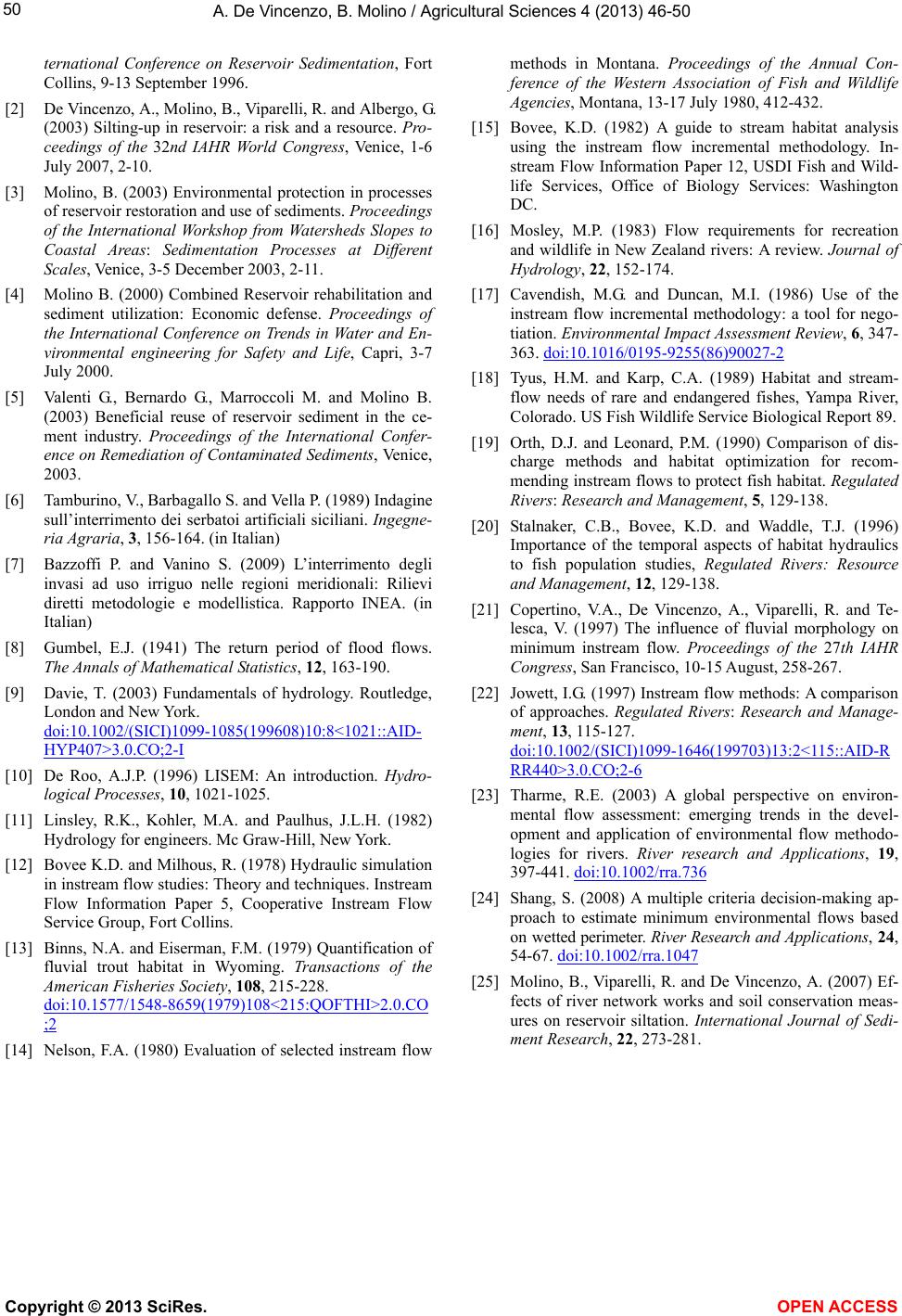
A. De Vincenzo, B. Molino / Agricultural Sciences 4 (2013) 46-50
Copyright © 2013 SciRes. OPEN ACC ESS
50
ternational Conference on Reservoir Sedimentation, Fort
Collins, 9-13 September 1996.
[2] De Vincenzo, A., Molino, B., Viparelli, R. and Albergo, G.
(2003) Silting-up in reservoir: a risk and a resource. Pro-
ceedings of the 32nd IAHR World Congress, Venice, 1-6
July 2007, 2-10.
[3] Molino, B. (2003) Environmental protection in processes
of reservoir restoration and use of sediments. Proceedings
of the International Workshop from Watersheds Slopes to
Coastal Areas: Sedimentation Processes at Different
Scales, Venice, 3-5 December 2003, 2-11.
[4] Molino B. (2000) Combined Reservoir rehabilitation and
sediment utilization: Economic defense. Proceedings of
the International Conference on Trends in Water and En-
vironmental engineering for Safety and Life, Capri, 3-7
July 2000.
[5] Valenti G., Bernardo G., Marroccoli M. and Molino B.
(2003) Beneficial reuse of reservoir sediment in the ce-
ment industry. Proceedings of the International Confer-
ence on Remediation of Contaminated Sediments, Venice,
2003.
[6] Tamburino, V., Barbagallo S. and Vella P. (1989) Indagine
sull’interrimento dei serbatoi artificiali siciliani. Ingegne-
ria Agraria, 3, 156-164. (in Italian)
[7] Bazzoffi P. and Vanino S. (2009) L’interrimento degli
invasi ad uso irriguo nelle regioni meridionali: Rilievi
diretti metodologie e modellistica. Rapporto INEA. (in
Italian)
[8] Gumbel, E.J. (1941) The return period of flood flows.
The Annals of Mathematical Statistics, 12, 163-190.
[9] Davie, T. (2003) Fundamentals of hydrology. Routledge,
London and New York.
doi:10.1002/(SICI)1099-1085(199608)10:8<1021::AID-
HYP407>3.0.CO;2-I
[10] De Roo, A.J.P. (1996) LISEM: An introduction. Hydro-
logical Processes, 10, 1021-1025.
[11] Linsley, R.K., Kohler, M.A. and Paulhus, J.L.H. (1982)
Hydrology for engineers. Mc Graw-Hill, New York.
[12] Bovee K.D. and Milhous, R. (1978) Hydraulic simulation
in instream flow studies: Theory and techniques. Instream
Flow Information Paper 5, Cooperative Instream Flow
Service Group, Fort Collins.
[13] Binns, N.A. and Eiserman, F.M. (1979) Quantification of
fluvial trout habitat in Wyoming. Transactions of the
American Fisheries Society, 108, 215-228.
doi:10.1577/1548-8659(1979)108<215:QOFTHI>2.0.CO
;2
[14] Nelson, F.A. (1980) Evaluation of selected instream flow
methods in Montana. Proceedings of the Annual Con-
ference of the Western Association of Fish and Wildlife
Agencies, Montana, 13-17 July 1980, 412-432.
[15] Bovee, K.D. (1982) A guide to stream habitat analysis
using the instream flow incremental methodology. In-
stream Flow Information Paper 12, USDI Fish and Wild-
life Services, Office of Biology Services: Washington
DC.
[16] Mosley, M.P. (1983) Flow requirements for recreation
and wildlife in New Zealand rivers: A review. Journal of
Hydrology, 22, 152-174.
[17] Cavendish, M.G. and Duncan, M.I. (1986) Use of the
instream flow incremental methodology: a tool for nego-
tiation. Environmental Impact Assessment Review, 6, 347-
363. doi:10.1016/0195-9255(86)90027-2
[18] Tyus, H.M. and Karp, C.A. (1989) Habitat and stream-
flow needs of rare and endangered fishes, Yampa River,
Colorado. US Fish Wildlife Service Biological Report 89.
[19] Orth, D.J. and Leonard, P.M. (1990) Comparison of dis-
charge methods and habitat optimization for recom-
mending instream flows to protect fish habitat. Regulated
Rivers: Research and Management, 5, 129-138.
[20] Stalnaker, C.B., Bovee, K.D. and Waddle, T.J. (1996)
Importance of the temporal aspects of habitat hydraulics
to fish population studies, Regulated Rivers: Resource
and Management, 12, 129-138.
[21] Copertino, V.A., De Vincenzo, A., Viparelli, R. and Te-
lesca, V. (1997) The influence of fluvial morphology on
minimum instream flow. Proceedings of the 27th IAHR
Congress, San Francisco, 10-15 August, 258-267.
[22] Jowett, I.G. (1997) Instream flow methods: A comparison
of approaches. Regulated Rivers: Research and Manage-
ment, 13, 115-127.
doi:10.1002/(SICI)1099-1646(199703)13:2<115::AID-R
RR440>3.0.CO;2-6
[23] Tharme, R.E. (2003) A global perspective on environ-
mental flow assessment: emerging trends in the devel-
opment and application of environmental flow methodo-
logies for rivers. River research and Applications, 19,
397-441. doi:10.1002/rra.736
[24] Shang, S. (2008) A multiple criteria decision-making ap-
proach to estimate minimum environmental flows based
on wetted perimeter. River Research and Applications, 24,
54-67. doi:10.1002/rra.1047
[25] Molino, B., Viparelli, R. and De Vincenzo, A. (2007) Ef-
fects of river network works and soil conservation meas-
ures on reservoir siltation. International Journal of Sedi-
ment Research, 22, 273-281.